A guide to street photography: Matt Stuart, manners and human autofocus

Street photography is the purest, most spontaneous way to create art with a camera. No studios, no props, no poses; all you need is the right equipment and a street with people on it. In this original series for Engadget, we'll follow three seasoned street fighters and try to glean some practical wisdom about what engages their eyes, brains and fingers in the moments before they shoot.
We learned about manual exposure in the last installment. Now we're going all in with a look at manual focusing. Our guide is Matt Stuart, a London-based photographer who's made his name with funny and quirky shots of humanity going about its business; shots that often materialize and then disappear so quickly that even the fastest autofocus system would fail to keep up. Since Stuart's style often involves stepping right up to people, almost to the point of invading their personal space, we'll also try to figure out how he manages to avoid confrontation.
The photographer
"I don't appreciate you abusing my human rights," said the woman, stepping in front of my lens.
"I wasn't filming you," I replied, pointing my video camera down at the ground. "I was filming him."
I nodded toward Stuart, who stood a few meters away from me, oblivious to the fact that I was caught up in a debate with an angry citizen. Leaving me to fend for myself, he continued to snatch unauthorized portraits of passersby, often just a few feet from their faces, while they barely seemed to notice, much less complain about it.
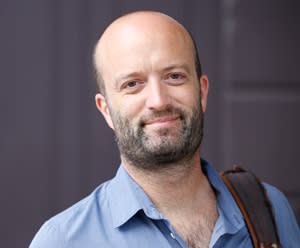
During his 18 years shooting on the street, Stuart has mastered the art of being inconspicuous. Like Antonio Olmos, who we met earlier in this series, his focus is on London street life and on finding shots good enough to publish in books and compilations such as Street Photography Now. However, very much unlike Olmos, he's all about finding humor and playfulness in everyday scenes. He's also on the lookout for flashes of color amid the drab grays of the urban street -- flashes that are rarer and more precious than you might imagine.
The gear
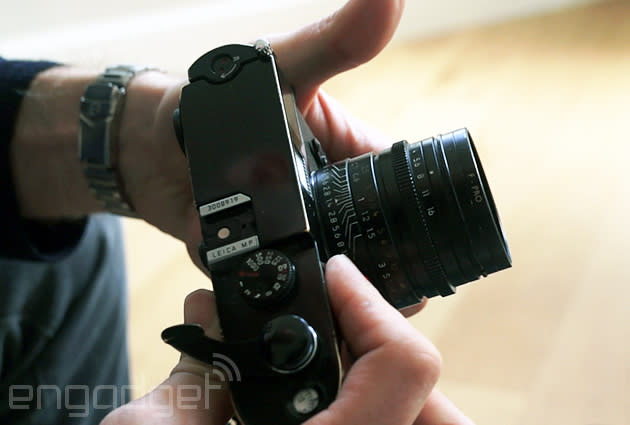
Disappearing into the background is Stuart's way of allowing funny and colorful scenes to unfold, uncontaminated by his presence. Shooting on a small camera is an essential part of the disguise. Although Stuart shoots digital for commercial commissions, his street photography is captured on a celluloid-format and entirely mechanical Leica MP.
Introduced in 2003, Leica's "Mechanical Perfection" camera continued a long line of so-called rangefinder cameras -- devices that forgo the big, noisy mirror system of an SLR, but retain an optical viewfinder that gives the photographer an approximate idea of what the camera sees.
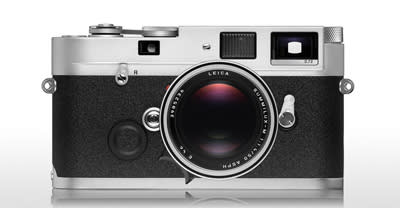
A Leica MP body will easily set you back $5,000 these days, putting it in a different league to Olmos' Canon 5D Mark II and also making it far more expensive than some current digital rangefinder-style cameras. Fujifilm's X-Pro1 is a good example of what digital equivalents can accomplish: It has an optical viewfinder that cleverly adjusts itself to the attached lens, and it costs around $1,200 body-only, or $2,100 with a street-friendly lens (like the X Mount 23mm f/1.4). Other models in Fujifilm's X-mount range forgo the optical viewfinder, and can't match the Leica for frame size, but have much more accessible prices. The same can be said of Sony's RX100 and RX100 MkII compacts, so you don't need to spend more than around $700 for capable digital kit. It's also worth noting that Nikon has recently been pushing boundaries in terms of trying to shrink pro-class DSLRs down to something closer to rangefinder size, with the Nikon Df for less than $3,000.
But Stuart is sticking with celluloid, even with the additional costs of film stock and processing, which can easily run to $150 per day. In return, he's getting a small, quiet camera that feels amazing to hold and which shoots images with immaculate detail from finely crafted lens and effectively infinite (or at least molecular) resolution from the use of ISO 400 film. Importantly, he's also benefiting from a form factor that is perfectly suited to rapid manual focus -- something that is as important to Stuart's style of photography as manual exposure is to Olmos' approach.
The Technique
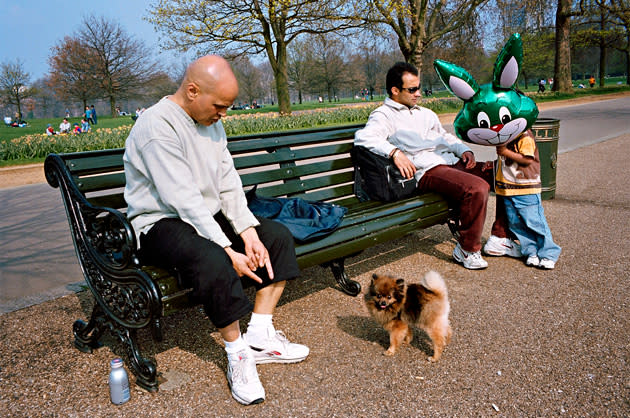
Put simply, Stuart likes to get right up in people's grills. And he likes to do it quickly and quietly, so he can reel off some shots before he's noticed. This approach requires some specific mannerisms. The average, properly raised amateur photographer might adopt a smiley, conciliatory attitude on the street, but Stuart's demeanor is the exact opposite: no eye contact, no apologies, no sheepishness. Just a blank expression that seems to say, "It's not about you -- I'm only here for the photo."
There's another challenge: How do you keep people in focus when both you and they are walking quickly, and often moving in opposite directions? Outside of the priciest DSLRs, autofocus modules can barely cope with challenges like this, and Stuart's camera lacks any degree of autofocus (or auto-anything) to begin with.
"The average, properly raised amateur photographer might adopt a smiley, conciliatory attitude on the street, but Stuart's demeanor is the exact opposite."
The answer is a useful little phenomenon called hyperfocal distance. Sean Arbabi covered it in some depth on Engadget back in 2011, but Stuart has his own specific way of making use of it. To start with, Stuart sets exposure to match the brightness of the street, generally aiming for an f-stop of f/11 on a sunny day, and a shutter speed of 1/500th to minimize motion blur of fast-moving subjects.
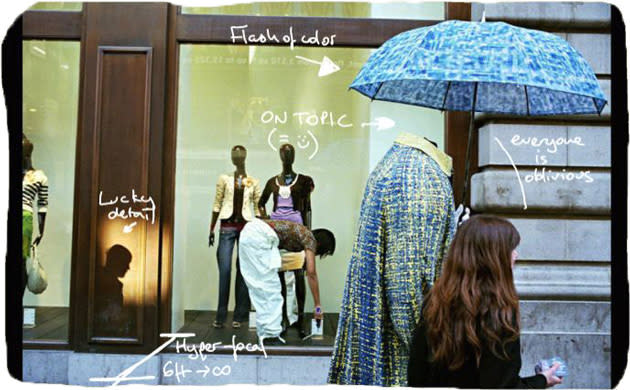
Now that he knows his f-stop, Stuart can figure out his hyperfocal distance. This is the distance at which he should focus his lens if he wants to guarantee that as many people as possible will be sharp in his photos. If he gets his hyperfocal distance right (usually around 12 feet), this will mean that anyone standing more than six feet from his lens (i.e., half of the hyperfocal distance) will be sharp. So long as he's not trying to capture anyone who's less than half the hyperfocal distance away, he won't have to touch his focus ring and can concentrate on taking the photo.
What happens if someone comes closer than six feet? In that situation, Stuart will quickly pull his lens to a second setting, which captures anyone who is between three and six feet from the lens. This way, Stuart only has to remember two focus settings, which may as well be called "near" (covering three to six feet) and "far" (covering six feet and beyond). In this way, Stuart is able to focus quicker than any autofocus system, and he's able to do so while barely thinking about it -- just as with Olmos' exposure technique, it's a force of habit.
"In this way, Stuart is able to focus quicker than any autofocus system, and he's able to do so while barely thinking about it."
You can replicate Stuart's technique on any digital camera with decent control over manual focus -- especially if it has a focus ring that makes it easy to memorize the feel of certain positions without having to look. If you know the focal length of your lens, and the size of your image frame (e.g., APS-C or Micro Four Thirds), then you can find hyperfocal distances for each f-stop at ePhotozine.
Wrap-up
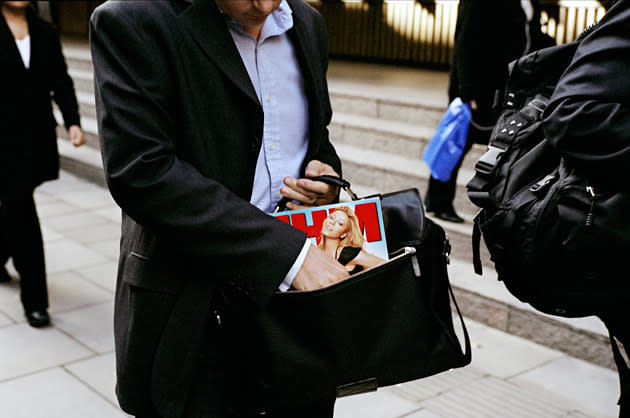
We've seen the two key ways in which Stuart manages to grab shots of strangers without their permission: his manner and facial expressions, which radiate a sort of disengaged matter-of-factness that stops people from taking things personally, and his routine use of hyperfocal distance, which lets him move and shoot quickly without stopping to adjust his lens. When it comes to the latter technique, however, there's another important consequence of the way he uses his rangefinder camera, even though it's not something he alluded to himself.
Stuart isn't distracted by what's going on in the distance, in the treetops or second-floor windows or inside passing cars.
If you watch Stuart in action, you'll see that he tends to focus (mentally and optically) on subjects that are, very approximately, between six and 16 feet away. This doesn't just have the merit of producing sharp photos when he's at his default 12-foot hyperfocal setting, but it also likely helps to narrow his field of attention. In other words, Stuart isn't distracted by what's going on in the distance, in the treetops or second-floor windows or inside passing cars. He's looking for subjects that are either close enough to capture right away, or close enough that he can rush toward them before they disappear.
A guide to street photography
When we factor in Stuart's fixed 35mm lens, which prevents him from zooming in or out, and his avoidance of shots that don't jibe with his theme of color and humor ("Buster Keaton moments"), there are plenty of little happenings on the street that he's able to ignore. In fact, during a couple of hours of shooting, Stuart only used up a couple of reels, taking perhaps half as many shots as Olmos did. This approach might reduce the probability of a purely random, lucky photo, but it leaves Stuart better prepared to spot that one magical shot that will tell the kind of story he's looking for.
You'll find more of Matt Stuart's work over at his site, mattstuart.com. And you'll also find more on street photography if you check back here tomorrow, as we'll have the third piece in this street photography guide: Gavin Harrison, filters and shooting without camera.








